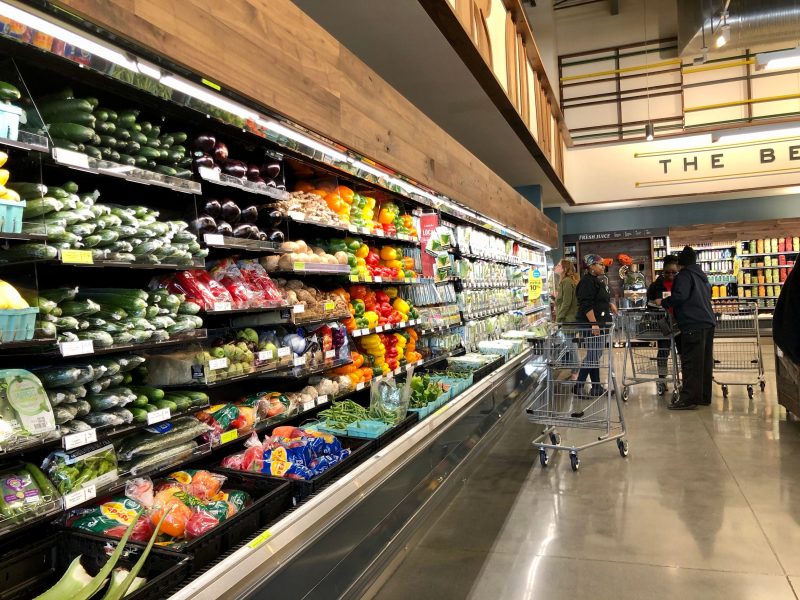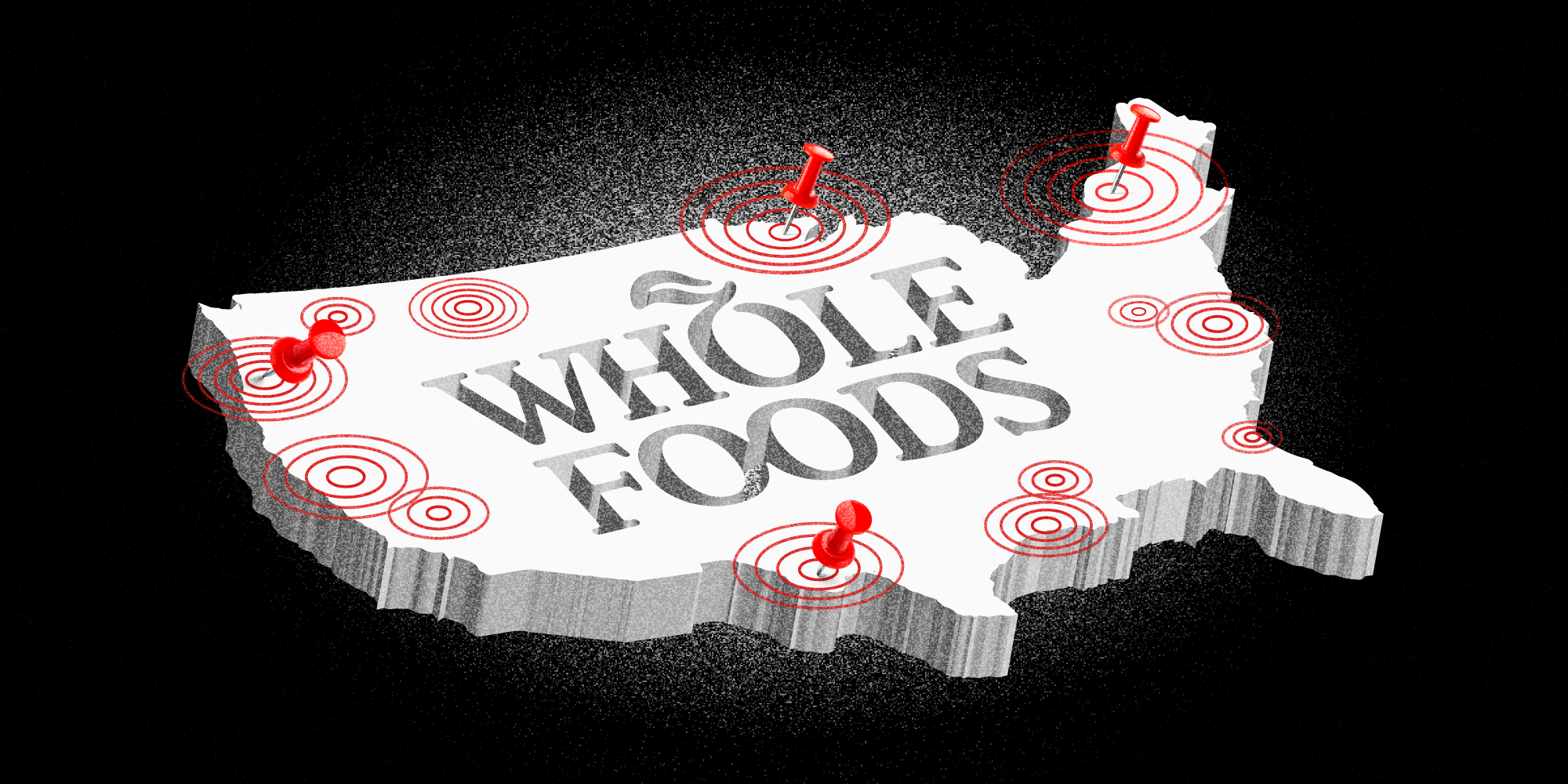- Amazon-owned Whole Foods is tracking and scoring stores it deems at risk of unionizing, according to five people with knowledge of the effort and internal documents viewed by Business Insider.
- The scores are based on more than two dozen metrics, including racial diversity, employee loyalty, “tipline” calls, and violations recorded by the Occupational Safety and Health Administration.
- In response to this story, Whole Foods said: “Whole Foods Market recognizes the rights of our Team Members to decide whether union representation is right for them. We agree with the overwhelming majority of our Team Members that a direct relationship with Whole Foods Market and its leadership, where Team Members have open lines of communication and every individual is empowered to share feedback directly with their team leaders, is best.”
- Tracking active or potential unionization is a common practice among large companies, according to labor experts.
- Visit Business Insider’s homepage for more stories.
Whole Foods is keeping an eye on stores at risk of unionizing through an interactive heat map, according to five people with knowledge of the matter and internal documents viewed by Business Insider.
The heat map is powered by an elaborate scoring system, which assigns a rating to each of Whole Foods’ 510 stores based on the likelihood that their employees might form or join a union.
The stores’ individual risk scores are calculated from more than two dozen metrics, including employee “loyalty,” turnover, and racial diversity; “tipline” calls to human resources; proximity to a union office; and violations recorded by the Occupational Safety and Health Administration.
The map also tracks local economic and demographic factors such as the unemployment rate in a store’s location and the percentage of families in the area living below the poverty line.
The stores' scores on each metric are fed into the heat map, which is a geographic illustration of the United States peppered with red spots to indicate high-risk Whole Foods stores.
The heat map reveals how Whole Foods is using technology and data to help manage its vast workforce of more than 95,000 employees.
It also provides a rare look into corporate labor-tracking activities, a common practice among large companies but one rarely discussed publicly.
A statement on the map describes its purpose as specific to monitoring unionization among its employees, which the company calls team members.
"The [Team Member] Relations Heatmap is designed to identify stores at risk of unionization," the statement reads. "This early identification enables resources to be funneled to the highest need locations, with the goal of mitigating risk by addressing challenges early before they become problematic."
Whole Foods did not respond to questions about what sort of resources are funneled to the "highest need" stores.
In a statement provided to Business Insider, the company said an "overwhelming majority" of its employees prefer a "direct relationship" with the company over union representation.
"Whole Foods Market recognizes the rights of our Team Members to decide whether union representation is right for them," the company said. "We agree with the overwhelming majority of our Team Members that a direct relationship with Whole Foods Market and its leadership, where Team Members have open lines of communication and every individual is empowered to share feedback directly with their team leaders, is best.
"Our open-door communication policy allows us to understand and quickly respond to the needs of our workforce, while recognizing, rewarding, and supporting the goals of every member of our team," the statement continued. "At Whole Foods Market, we're committed to treating all of our Team Members fairly, creating a safe, inclusive, and empowering working environment, and providing our Team Members with career advancement opportunities, great benefits, and competitive compensation, including an industry-leading starting minimum wage of $15/hour."
How Whole Foods calculates a store's risk of unionizing

Whole Foods uses the heat map and related scores to determine where stores must take action to address risks, according to the documents and people familiar with the map.
Overall, higher scores indicate lower risks of unionization.
The map monitors three main areas: "external risks," "store risks," and "team member sentiment."
Some of the factors that contribute to external risk scores include local union membership size; distance in miles between the store and the closest union; number of charges filed with the National Labor Relations Board alleging labor-law violations; and a "labor incident tracker," which logs incidents related to organizing and union activity.
Other external factors include the percentage of families within the store's zip code that fall below the poverty line and the local unemployment rate.
Whole Foods' heat map says lower rates of racial diversity increase unionization risks
The second group of metrics in the scoring system, called store risks, aren't a direct cause of risk "but can predispose a store to risk," according to documents.
Store-risk metrics include average store compensation, average total store sales, and a "diversity index" that represents the racial and ethnic diversity of every store. Stores at higher risk of unionizing have lower diversity and lower employee compensation, as well as higher total store sales and higher rates of workers' compensation claims, according to the documents.
The third area of metrics is "team member sentiment." These metrics, which include items like employee loyalty and engagement, are "designed to be the most actionable," the documents show.
The "sentiment" data is pulled from internal employee surveys and "is likely to be the first score to improve based on your efforts."
These measures assess employees' feedback on the quality and safety of their work environment and whether they feel supported and respected, among other things.
Tracking potential unionization is common among large companies
With the heat map, Whole Foods appears to be trying to identify and address circumstances ripe for employee unrest that could lead to attempts to form a union.
This type of workforce analysis is something large companies have done for decades, albeit without some of the technology available today that can automate parts of that process, according to labor experts.
Walmart, for example, hired an intelligence-gathering service from Lockheed Martin and ranked stores by labor activity when it faced protests eight years ago organized by the union-backed activist group OUR Walmart, according to a 2015 Bloomberg Businessweek story citing thousands of court documents.
"Employers spend millions of dollars a year to hire union avoidance advisers to see how susceptible they are to their workers organizing," Celine McNicholas, the director of government affairs and labor counsel for the Economic Policy Institute, said.
Why some companies closely track union activity
"A preponderance of the business community [has] a total allergy to unionization," Wilma Liebman, who served on the National Labor Relations Board under Presidents Obama, Bush, and Clinton, said.
Unions give employees more bargaining power over things such as wages and health benefits, she said. They could also increase the chances of employee strikes, which can disrupt business.
Companies "don't want anything that's going to interfere with their autonomy and their ability to act unilaterally" and "sometimes they're convinced [unions] are going to cost them more than they can afford," Liebman said.
Research shows unionized workers tend to earn higher wages and are more likely to have access to certain benefits like employer-sponsored healthcare.
Critics of unions argue, however, that the organizations can harm companies economically, forcing layoffs or job outsourcing, and that they don't have workers' best interests in mind.
That's why some companies monitor their workers to try to address any signs that employees might organize head-on.
US labor law protects employees' right to unionize. It's legal, however, for a company to monitor and address labor organizing as long as it doesn't threaten, coerce, restrain, or interfere with efforts to unionize.
Overall, US companies spent at least $100 million on consulting services for anti-union campaigns between 2014 and 2017, according to data from the Economic Policy Institute based on disclosure forms filed with the US Department of Labor.
McNicholas said using a data-powered heat map to monitor for unionization risks "is just the next frontier of employer opposition to unions."
If you are an employee of Whole Foods and have information to share, contact this reporter at [email protected].

